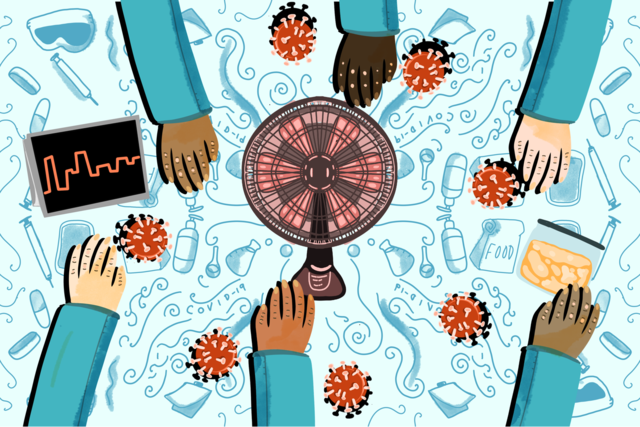Scientists and experts around the world are researching solutions to COVID-19. At Carleton University, numerous innovative projects are underway to help combat the spread of the virus and its symptoms.
The Charlatan spoke to three researchers about their projects.
Using artificial intelligence to design protein
A Carleton research team is using supercomputers and artificial intelligence (AI) to build synthetic proteins to fight COVID-19 and help those who have contracted the virus.
While proteins must physically touch each other to carry out tasks, the team has developed a protein that binds to the surface of SARS-CoV-2 and blocks receptors from interacting with it. This can stop the virus from replicating.
The team is led by Carleton biology professor Ashkan Golshani.
Using artificial intelligence, Golshani said the team is able to design peptides to bind to the surface of SARS-CoV-2.
“We have two peptides with the ability to reduce virus replication by 75 per cent and 50 per cent, respectively,” Golshani said in an email.
Eventually, the peptides could be used to treat people who have contracted COVID-19.
Perfecting food consistency
A less common symptom of COVID-19 is dysphagia, or difficulty swallowing, which can lead to choking and malnutrition.
Farah Hosseinian, a professor of chemistry at Carleton, has been working closely with health care food provider Apetito HFS to improve the quality of pureed foods, which individuals with dysphagia may rely on.
When pureed foods are thawed from frozen, they can become too runny for patients to consume.
“Using our expertise and skills, we are developing a type of emulsion, called double emulsion, that encapsulates/protects the soup from quickly breaking down in the mouth of patients,” Hosseinian said in an email.
Emulsion is the mixture of two or more naturally-separated liquids, like oil and water.
“We have an ultrasound technology doing this without [the] addition of any chemicals,” Hosseinian said.
Hosseinian said more tests are needed to make sure the process is “suitable for elders with dysphagia problems.”
Preventing transmission with ventilation
Controlling air ventilation through HVAC units is key to preventing COVID-19 transmission.
Before COVID-19, the goal was for each person in a building to have 10 litres of air per second, according to Tareq Abuimara, a contract instructor in Carleton’s department of civil and environmental engineering and member of a research team studying ventilation.
Now, researchers are trying to figure out how to achieve higher levels of ventilation—and how much fresh air is needed.
“You can’t predict how many people there will be and where they will be located [in the building],” Abuimara said, explaining that uncertainty over where people are poses problems for ventilation.
Additional factors in air circulation include the type of building, the building layout and the type of work being done.
One challenge for the researchers is Canada’s climate. In cold weather, it’s not feasible to pump 100 per cent fresh air into a building.
Instead, Abuimara and the research team are trying to find an appropriate level of fresh air that doesn’t overwhelm the HVAC system but still limits the spread of COVID-19
* * *
In June, Carleton launched the Carleton University COVID-19 Rapid Response Research Grants competition, which invested more than $800,000 in 59 projects underway at the university. One of the projects was Golshani’s development of synthetic proteins.
Likewise, in October, nine Carleton research projects received $450,000 in funding from the Natural Sciences and Engineering Research Council of Canada. Hosseinian’s dysphagia research was one recipient of the funding.
As part of these ongoing projects, Carleton researchers continue to develop ways to overcome barriers posed by the pandemic.






